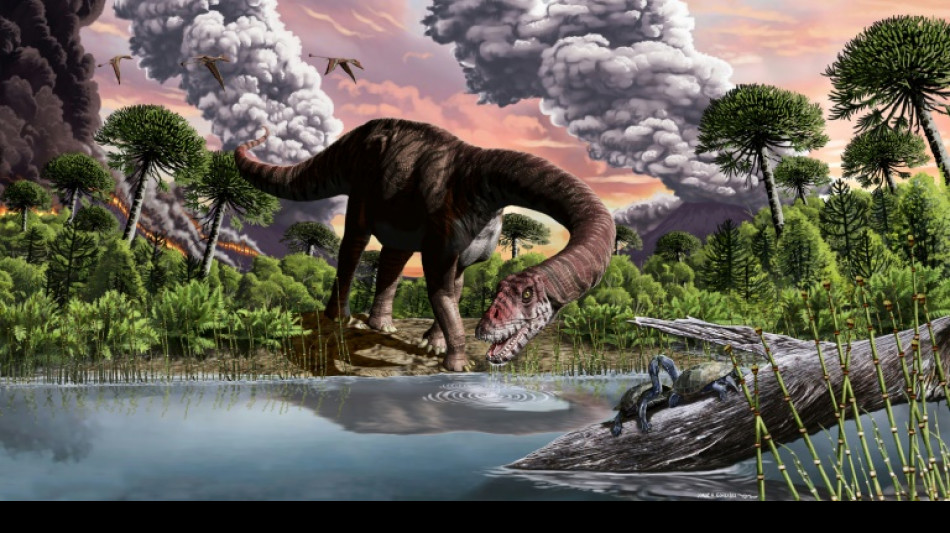
-
 Gloves off, Red run, vested interests: Singapore GP talking points
Gloves off, Red run, vested interests: Singapore GP talking points
-
Bills, Eagles lose unbeaten records in day of upsets

-
 Muller on target as Vancouver thrash San Jose to go joint top
Muller on target as Vancouver thrash San Jose to go joint top
-
Tokyo soars, yen sinks after Takaichi win on mixed day for Asia

-
 China's chip challenge: the race to match US tech
China's chip challenge: the race to match US tech
-
UN rights council to decide on creating Afghanistan probe

-
 Indonesia sense World Cup chance as Asian qualifying reaches climax
Indonesia sense World Cup chance as Asian qualifying reaches climax
-
ICC to give war crimes verdict on Sudan militia chief

-
 Matthieu Blazy to step out as Coco's heir in Chanel debut
Matthieu Blazy to step out as Coco's heir in Chanel debut
-
Only man to appeal in Gisele Pelicot case says not a 'rapist'

-
 Appetite-regulating hormones in focus as first Nobel Prizes fall
Appetite-regulating hormones in focus as first Nobel Prizes fall
-
Gisele Pelicot: French rape survivor and global icon

-
 Negotiators due in Egypt for Gaza talks as Trump urges quick action
Negotiators due in Egypt for Gaza talks as Trump urges quick action
-
'My heart sank': Surging scams roil US job hunters

-
 Competition heats up to challenge Nvidia's AI chip dominance
Competition heats up to challenge Nvidia's AI chip dominance
-
UK police to get greater powers to restrict demos

-
 Guerrero grand slam fuels Blue Jays in 13-7 rout of Yankees
Guerrero grand slam fuels Blue Jays in 13-7 rout of Yankees
-
Five-try Bayonne stun champions Toulouse to go top in France

-
 Fisk reels in Higgo to win maiden PGA Tour title in Mississippi
Fisk reels in Higgo to win maiden PGA Tour title in Mississippi
-
Aces overpower Mercury for 2-0 lead in WNBA Finals

-
 Bayonne stun champions Toulouse to go top in France
Bayonne stun champions Toulouse to go top in France
-
Greta Thunberg among Gaza flotilla detainees to leave Israel

-
 Atletico draw at Celta Vigo after Lenglet red card
Atletico draw at Celta Vigo after Lenglet red card
-
Ethan Mbappe returns to haunt PSG as Lille force draw with Ligue 1 leaders

-
 Hojlund fires Napoli into Serie A lead as AC Milan held at Juve
Hojlund fires Napoli into Serie A lead as AC Milan held at Juve
-
Vampires, blood and dance: Bollywood horror goes mainstream

-
 Broncos rally snaps Eagles unbeaten record, Ravens slump deepens
Broncos rally snaps Eagles unbeaten record, Ravens slump deepens
-
Former NFL QB Sanchez charged after allegedly attacking truck driver

-
 France unveils new government amid political deadlock
France unveils new government amid political deadlock
-
Child's play for Haaland as Man City star strikes again

-
 India crush Pakistan by 88 runs amid handshake snub, umpiring drama
India crush Pakistan by 88 runs amid handshake snub, umpiring drama
-
Hojlund fires Napoli past Genoa and into Serie A lead

-
 Sevilla rout 'horrendous' Barca in Liga thrashing
Sevilla rout 'horrendous' Barca in Liga thrashing
-
Haaland fires Man City to win at Brentford, Everton end Palace's unbeaten run

-
 Haaland extends hot streak as Man City sink Brentford
Haaland extends hot streak as Man City sink Brentford
-
Italy working hard to prevent extra US tariffs on pasta

-
 Sinner out of Shanghai Masters as Djokovic battles into last 16
Sinner out of Shanghai Masters as Djokovic battles into last 16
-
Swift rules N. America box office with 'Showgirl' event

-
 Ryder Cup hero MacIntyre wins Alfred Dunhill Links on home soil
Ryder Cup hero MacIntyre wins Alfred Dunhill Links on home soil
-
Republicans warn of pain ahead as US shutdown faces second week

-
 Sevilla rout champions Barca in shock Liga thrashing
Sevilla rout champions Barca in shock Liga thrashing
-
Norris-Piastri clash overshadows McLaren constructors' title win

-
 Trump administration declares US cities war zones
Trump administration declares US cities war zones
-
Bad Bunny takes aim at Super Bowl backlash in 'SNL' host gig

-
 El Khannouss fires Stuttgart into Bundesliga top four
El Khannouss fires Stuttgart into Bundesliga top four
-
Insatiable Pogacar romps to European title

-
 Newcastle inflict more pain on Postecoglou, Everton end Palace's unbeaten run
Newcastle inflict more pain on Postecoglou, Everton end Palace's unbeaten run
-
Daryz wins Prix de l'Arc de Triomphe thriller

-
 Russell wins Singapore GP as McLaren seal constructors' title
Russell wins Singapore GP as McLaren seal constructors' title
-
Landslides and floods kill 64 in Nepal, India


Faeces, vomit offer clues to how dinosaurs rose to rule Earth
Faeces, vomit and fossilised food from inside stomachs have provided new clues into how dinosaurs rose to dominate Earth, a new study revealed on Wednesday.
Scientists have discovered plenty about dinosaurs -- particularly about how they vanished off the face of the planet 66 millions years ago.
But "we know very little about their rise," Martin Qvarnstrom, a researcher at Sweden's Uppsala University and the study's lead author, told AFP.
Dinosaurs first appeared at least 230 million years ago, fossils have shown.
But they would not become the world's dominant animal until the start of the Jurassic Period some 30 million years later.
What caused this ascension -- and why it took so long -- have long been a subject of fevered debate between scientists.
For the new study in Nature, a European team exhaustively probed more than 500 "bromalites" -- the fossilised remains of dinosaur faeces, vomit and undigested food inside intestines -- from sites in Poland.
"By linking the bromalites to the producers and identifying what's in them, we can start connecting who ate whom or who ate what," Qvarnstrom explained.
The researchers used new technology such as synchrotron microtomography to build a 3D image of the samples.
This revealed that the excrement contained the remains of insects, plants, fish and bigger animals.
The researchers compared this with data about fossils, plants and the climate to construct a model for the step-by-step rise of the dinosaurs.
- 'Opportunistic animal' -
This ascension was illustrated by the bromalites themselves, which tripled in average length and width over the 30 million-year period.
This demonstrated how the animals that digested, vomited or excreted these remains tripled in size over that time.
Some of the fossilised remains belonged to an early ancestor of dinosaurs, the Silesaurus.
Far from the mighty T-Rex, the "pretty small" Silesaurus weighed around 15 kilograms at most, Qvarnstrom said.
The dominant animal at the time were barrel-chested herbivorous reptiles called Dicynodonts, which weighed a few tons.
But Silesaurus had a big advantage over its stocky rival -- it was omnivorous.
"What we see from its droppings is that it was eating a lot of insects, fish and plants," Qvarnstrom said.
This meant the "opportunistic animal" was better at adapting to sudden changes in the environment.
For example, a massively rainy period called the Carnian Pluvial Episode lead to the evolution of many new plants.
The big herbivorous reptiles struggled to adapt to this new diet.
But the Silesaurus -- and later long-necked dinosaurs that were ancestors of the Diplodocus -- "were able to just feast on all these new plants", Qvarnstrom said.
As the smaller dinosaurs grew bigger from this new grub, so did larger carnivores that fed on them.
By the time the Jurassic period rolled around, the landscape was dominated by giant plant-eating dinosaurs and ferocious carnivores.
- Two competing theories -
The study will not settle the debate about what led to the rule of dinosaurs once and for all.
There are two main theories for their rise. One is that early dinosaurs used key physiological advantages -- such as standing upright -- to outcompete their rivals.
The other is that environmental upheaval, such as volcanic eruptions or a changing climate, killed off many of the previously dominant animals, creating an opening at the top.
The researchers behind the bromalites study suggested it was a combination of the two theories, in which the dinosaurs used their evolutionary advantages to capitalise on environmental changes that had knocked back their rivals.
Lawrence Tanner, a researcher at Le Moyne College in New York, said the study "should be seen as a starting point for further work".
Although its methodology is "particularly creative", the study is "limited in its context and scope", Tanner commented in an attached Nature paper.
The research only covers the Polish Basin region, which at the time was part of the north of the Pangea supercontinent, he observed.
Qvarnstrom agreed, saying that he thought it would be "really cool" to use the model the team developed on other regions -- such as the south of Pangea, where the first dinosaurs appeared.
H.Weber--VB


